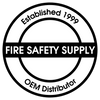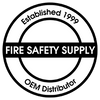The Essential Fire Safety Equipment Every Business Should Have
Posted by the FSS Team on Sep 27th 2024
Fire safety is a critical component of any business, regardless of size or industry. Equipping your workplace with the right fire safety equipment is not only a legal requirement but also a crucial step in protecting your employees, property, and operations. Here’s a comprehensive guide to the essential fire safety equipment every business should have and why it matters.
1. Fire Extinguishers
Fire extinguishers are the first line of defense against small fires and should be readily accessible throughout your business premises. Different types of fire extinguishers (A, B, C, D, and K) are designed to tackle different fire classes, such as fires involving electrical equipment, flammable liquids, or combustible metals. Ensure that you have the appropriate extinguisher type for the specific risks in your workplace and conduct regular inspections to keep them operational.
2. Smoke Alarms and Heat Detectors
Smoke alarms and heat detectors are essential for early fire detection, providing critical time to evacuate and minimize damage. Smoke alarms detect visible and invisible particles produced in a fire, while heat detectors respond to a rapid rise in temperature. Both are vital for alerting occupants to danger, particularly in areas where a fire could go unnoticed, such as storerooms, basements, or closed offices.
3. Emergency Exit Signs and Lighting
In the event of a fire, clear exit paths are crucial. Illuminated emergency exit signs and lighting guide occupants safely out of the building during an emergency, especially in low-visibility conditions caused by smoke. Regular checks should be conducted to ensure these signs are functioning correctly, and paths are kept clear.
4. Fire Blankets
Fire blankets are particularly useful for small fires involving cooking oils or clothing. They work by smothering flames, cutting off the fire’s oxygen supply. Fire blankets are an excellent safety addition to kitchens, laboratories, or any areas where open flames or high-heat equipment are used.
5. Sprinkler Systems
Sprinkler systems are one of the most effective fire suppression tools, automatically activating to douse flames when a fire is detected. They help control the spread of a fire until emergency services arrive, significantly reducing potential damage and preventing loss of life.
6. Fire Hoses and Hose Reels
Fire hoses and hose reels provide a powerful means to combat fires in large spaces. They are connected to the building’s water supply and can be used to direct water onto flames, controlling the spread of the fire before it grows out of control. These should be placed in easily accessible areas, and staff should be trained in their proper use.
7. Fire Safety Signs and Evacuation Maps
Proper signage is crucial during a fire emergency. Fire safety signs indicate the locations of fire extinguishers, alarms, exits, and other safety equipment, while evacuation maps help guide occupants to the nearest exit. Ensure that these signs and maps are updated regularly and are visible to everyone on the premises.
8. Fire Suppression Systems for Specific Risks
Certain industries, like restaurants and manufacturing, face unique fire risks that standard equipment may not cover. Specialized suppression systems, such as kitchen hood suppression units or chemical fire suppression for hazardous materials, are necessary to address these specific dangers.
Keeping Your Fire Safety Equipment Up to Date
Regular maintenance and inspection of your fire safety equipment are crucial to ensure it functions correctly during an emergency. Schedule routine checks, adhere to regulatory standards, and replace or repair faulty equipment immediately. Training employees on how to use fire safety tools can also make a significant difference during an actual event.
Protect Your Business with the Right Fire Safety Equipment
Investing in the right fire safety equipment is not just about compliance; it’s about safeguarding your business and its people. Fire Safety Supply offers a wide range of fire safety products and services to help you maintain a safe working environment. Contact us today to learn more about how we can help you equip your business with the necessary fire protection tools.
 Since 1999, Fire Safety Supply has been the go-to for fire suppression products, industrial dry chemical systems, high and low-pressure CO2, vehicles, and clean agents. We serve various types of industries such as restaurants, commercial kitchen, wineries, and more.
Since 1999, Fire Safety Supply has been the go-to for fire suppression products, industrial dry chemical systems, high and low-pressure CO2, vehicles, and clean agents. We serve various types of industries such as restaurants, commercial kitchen, wineries, and more.
